Page 247 of 360
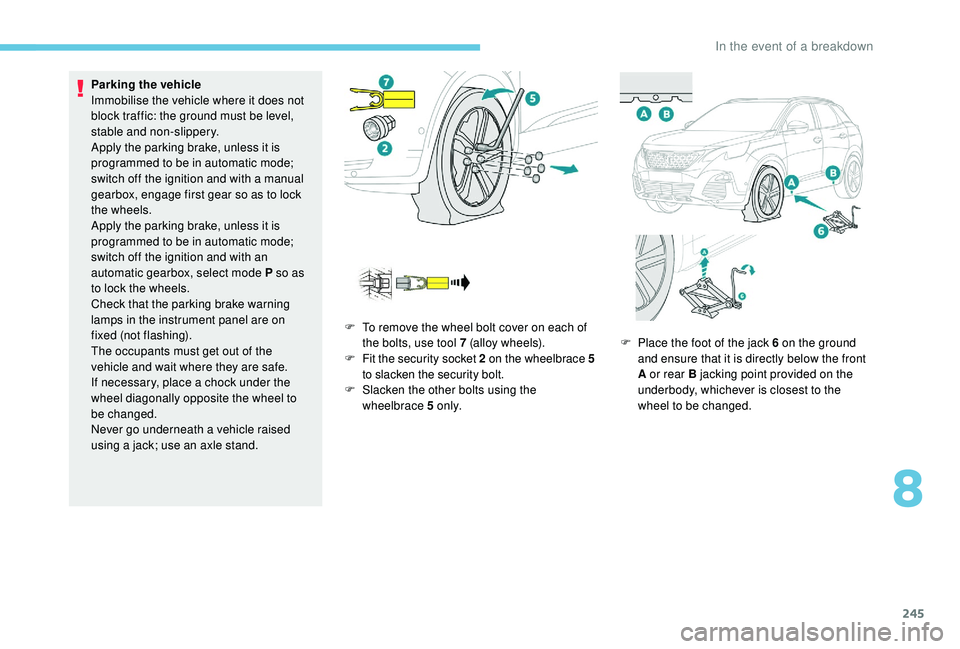
245
Parking the vehicle
Immobilise the vehicle where it does not
block traffic: the ground must be level,
stable and non-slippery.
Apply the parking brake, unless it is
programmed to be in automatic mode;
switch off the ignition and with a manual
gearbox, engage first gear so as to lock
the wheels.
Apply the parking brake, unless it is
programmed to be in automatic mode;
switch off the ignition and with an
automatic gearbox, select mode P so as
to lock the wheels.
Check that the parking brake warning
lamps in the instrument panel are on
fixed (not
flashing).
The occupants must get out of the
vehicle and wait where they are safe.
If necessary, place a chock under the
wheel diagonally opposite the wheel to
be changed.
Never go underneath a vehicle raised
using a jack; use an axle stand. F
T
o remove the wheel bolt cover on each of
the bolts, use tool 7 (alloy wheels).
F
F
it the security socket 2 on the wheelbrace
5
to slacken the security bolt.
F
S
lacken the other bolts using the
wheelbrace 5 o n l y. F
P
lace the foot of the jack 6 on the ground
and ensure that it is directly below the front
A or rear B jacking point provided on the
underbody, whichever is closest to the
wheel to be changed.
8
In the event of a breakdown
Page 259 of 360
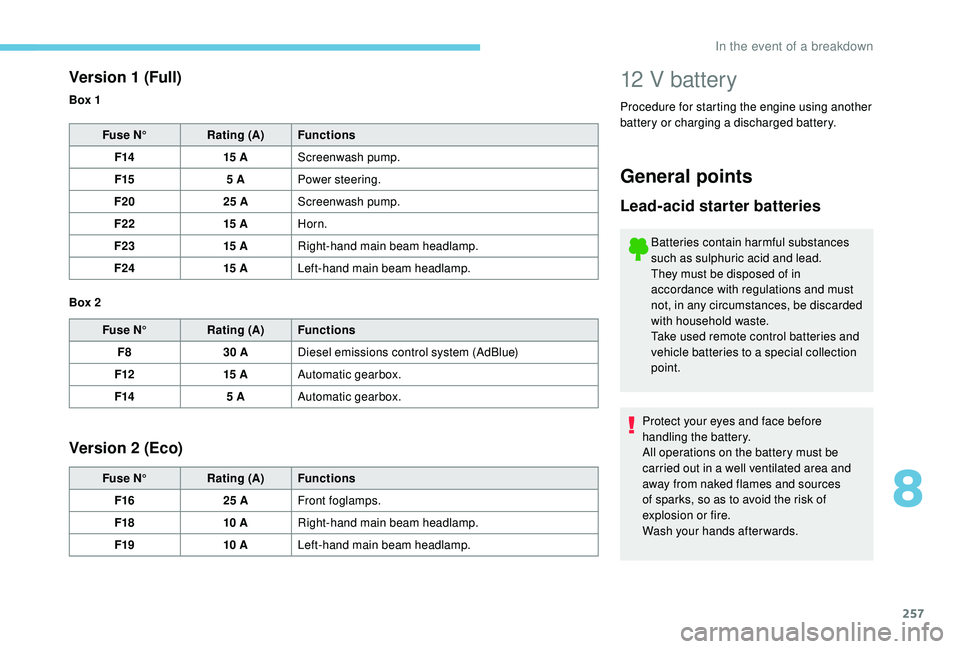
257
12 V battery
Procedure for starting the engine using another
battery or charging a discharged battery.
Version 1 (Full)
Fuse N° Rating (A) Functions
F14 15
AScreenwash pump.
F15 5
APower steering.
F20 25
AScreenwash pump.
F22 15
AHorn.
F23 15
ARight-hand main beam headlamp.
F24 15
ALeft-hand main beam headlamp.
Fuse N° Rating (A) Functions
F8 30
ADiesel emissions control system (AdBlue)
F12 15
AAutomatic gearbox.
F14 5
AAutomatic gearbox.
Version 2 (Eco)
Fuse N° Rating (A) Functions
F16 25
AFront foglamps.
F18 10
ARight-hand main beam headlamp.
F19 10
ALeft-hand main beam headlamp.
Box 1
Box 2
General points
Lead-acid starter batteries
Batteries contain harmful substances
such as sulphuric acid and lead.
They must be disposed of in
accordance with regulations and must
not, in any circumstances, be discarded
with household waste.
Take used remote control batteries and
vehicle batteries to a special collection
point.
Protect your eyes and face before
handling the battery.
All operations on the battery must be
carried out in a well ventilated area and
away from naked flames and sources
of sparks, so as to avoid the risk of
explosion or fire.
Wash your hands afterwards.
8
In the event of a breakdown
Page 261 of 360
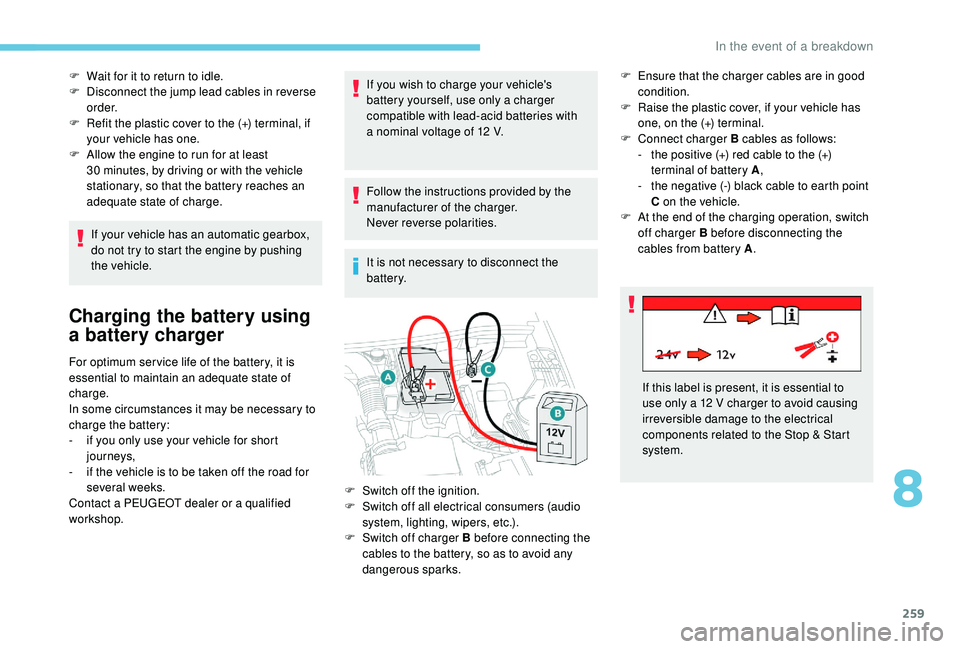
259
F Wait for it to return to idle.
F D isconnect the jump lead cables in reverse
o r d e r.
F
R
efit the plastic cover to the (+) terminal, if
your vehicle has one.
F
A
llow the engine to run for at least
30
minutes, by driving or with the vehicle
stationary, so that the battery reaches an
adequate state of charge.
If your vehicle has an automatic gearbox,
do not try to start the engine by pushing
the vehicle.
Charging the battery using
a battery charger
For optimum ser vice life of the battery, it is
essential to maintain an adequate state of
charge.
In some circumstances it may be necessary to
charge the battery:
-
i
f you only use your vehicle for short
journeys,
-
i
f the vehicle is to be taken off the road for
several weeks.
Contact a PEUGEOT dealer or a qualified
workshop. If you wish to charge your vehicle's
battery yourself, use only a charger
compatible with lead-acid batteries with
a nominal voltage of 12
V.
Follow the instructions provided by the
manufacturer of the charger.
Never reverse polarities.
It is not necessary to disconnect the
battery.
F
S
witch off the ignition.
F
S
witch off all electrical consumers (audio
system, lighting, wipers, etc.).
F
S
witch off charger B before connecting the
cables to the battery, so as to avoid any
dangerous sparks. F
E
nsure that the charger cables are in good
condition.
F
R
aise the plastic cover, if your vehicle has
one, on the (+) terminal.
F
C
onnect charger B cables as follows:
-
t
he positive (+) red cable to the (+)
terminal of battery A ,
-
t
he negative (-) black cable to earth point
C on the vehicle.
F
A
t the end of the charging operation, switch
off charger B before disconnecting the
cables from battery A .
If this label is present, it is essential to
use only a 12 V charger to avoid causing
irreversible damage to the electrical
components related to the Stop & Start
system.
8
In the event of a breakdown
Page 263 of 360
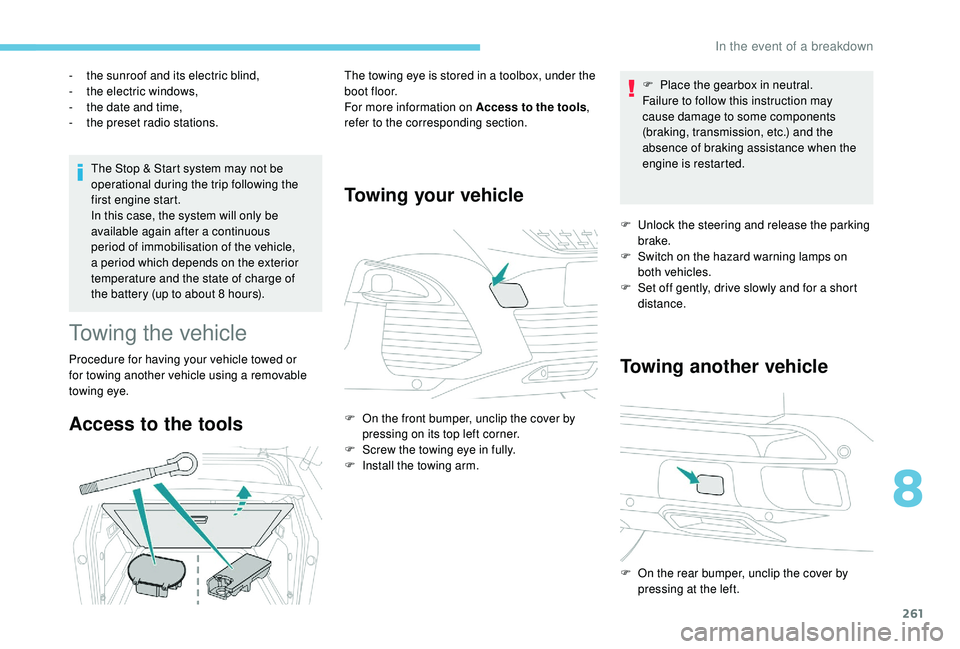
261
The Stop & Start system may not be
operational during the trip following the
first engine start.
In this case, the system will only be
available again after a continuous
period of immobilisation of the vehicle,
a period which depends on the exterior
temperature and the state of charge of
the battery (up to about 8 hours).
-
t
he sunroof and its electric blind,
-
t
he electric windows,
-
t
he date and time,
-
t
he preset radio stations.
Towing the vehicle
Procedure for having your vehicle towed or
for towing another vehicle using a removable
towing eye.
Access to the tools
The towing eye is stored in a toolbox, under the
boot floor.
For more information on Access to the tools
,
refer to the corresponding section.
Towing your vehicle
F On the front bumper, unclip the cover by pressing on its top left corner.
F
S
crew the towing eye in fully.
F
I
nstall the towing arm. F
P
lace the gearbox in neutral.
Failure to follow this instruction may
cause damage to some components
(braking, transmission, etc.) and the
absence of braking assistance when the
engine is restarted.
F
U
nlock the steering and release the parking
brake.
F
S
witch on the hazard warning lamps on
both vehicles.
F
S
et off gently, drive slowly and for a short
distance.
Towing another vehicle
F On the rear bumper, unclip the cover by pressing at the left.
8
In the event of a breakdown
Page 264 of 360
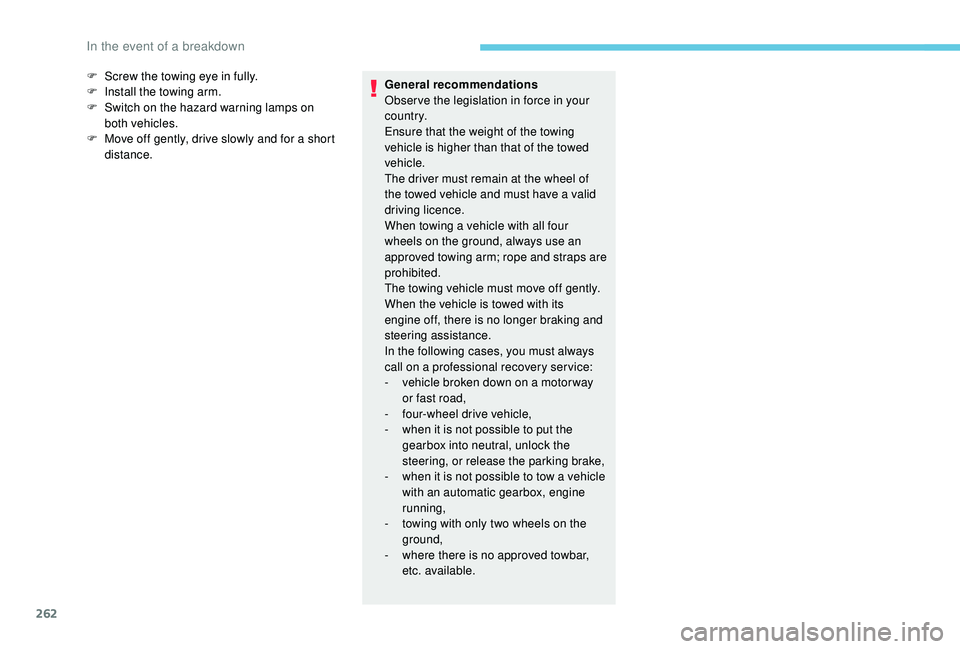
262
F Screw the towing eye in fully.
F I nstall the towing arm.
F
S
witch on the hazard warning lamps on
both vehicles.
F
M
ove off gently, drive slowly and for a short
distance. General recommendations
Obser ve the legislation in force in your
c o u nt r y.
Ensure that the weight of the towing
vehicle is higher than that of the towed
vehicle.
The driver must remain at the wheel of
the towed vehicle and must have a valid
driving licence.
When towing a vehicle with all four
wheels on the ground, always use an
approved towing arm; rope and straps are
prohibited.
The towing vehicle must move off gently.
When the vehicle is towed with its
engine off, there is no longer braking and
steering assistance.
In the following cases, you must always
call on a professional recovery ser vice:
-
v
ehicle broken down on a motor way
or fast road,
-
f
our-wheel drive vehicle,
-
w
hen it is not possible to put the
gearbox into neutral, unlock the
steering, or release the parking brake,
-
w
hen it is not possible to tow a vehicle
with an automatic gearbox, engine
running,
-
t
owing with only two wheels on the
ground,
-
w
here there is no approved towbar,
etc. available.
In the event of a breakdown
Page 266 of 360
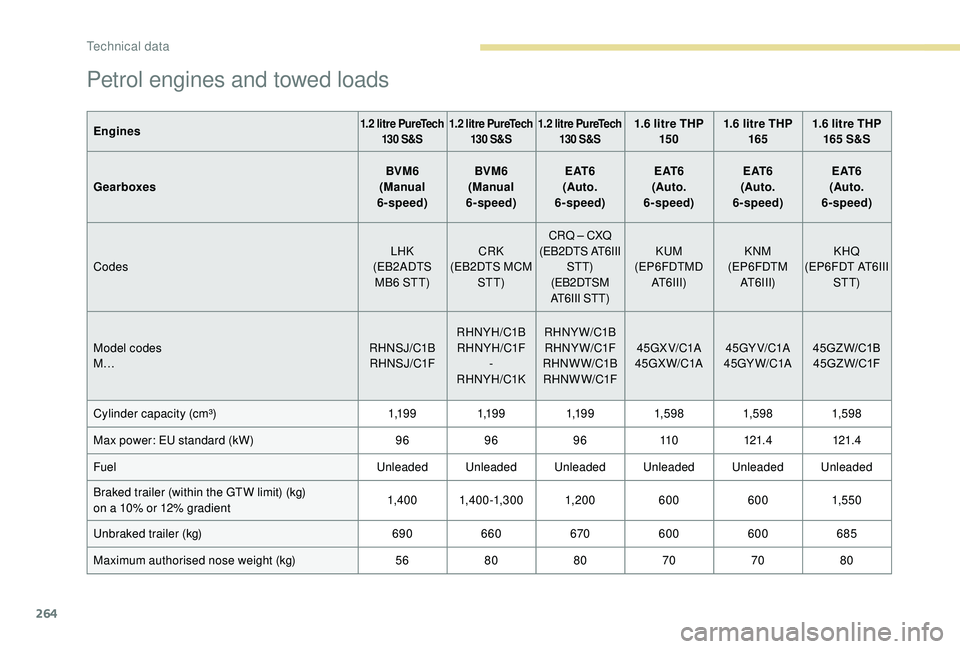
264
Petrol engines and towed loads
Engines1.2 litre PureTech 130 S&S 1.2 litre PureTech
130 S&S 1.2 litre PureTech
130 S&S1.6 litre THP 15 0 1.6 litre THP
165 1.6 litre THP
165 S&S
Gearboxes BVM6
(Manual
6-speed) BVM6
(Manual
6-speed) E AT 6
(Auto.
6-speed) E AT 6
(Auto.
6-speed) E AT 6
(Auto.
6-speed) E AT 6
(Auto.
6-speed)
Codes LHK
(EB2ADTS MB6 STT) CRK
(EB2DTS MCM STT) CRQ
– CXQ
(EB2DTS AT6III STT)
(EB2DTSM
AT6III STT) KUM
(EP6FDTMD AT6III) KNM
(EP6FDTM AT6III) KHQ
(EP6FDT AT6III STT)
Model codes
M… RHNSJ/C1B
RH NS J/C1F RHNYH/C1B
RHNYH/C1F -
RHNYH/C1K RHNYW/C1B
RHNYW/C1F
RHNW W/C1B RH NW W/C1F 45GX V/C1A
45GX W/C1A 45GY V/C1A
45GY W/C1A 45GZ W/C1B
45G Z W/C1F
Cylinder capacity (cm³) 1,1 9 91,1 9 91,1 9 91,59 8 1,59 81,59 8
Max power: EU standard (kW) 96969611 0121.4 121.4
Fuel Unleaded Unleaded Unleaded Unleaded Unleaded Unleaded
Braked trailer (within the GTW limit) (kg)
on a 10% or 12% gradient 1,4 0 0 1,4 0 0 -1,3 0 0 1, 20 0
6006001,550
Unbraked trailer (kg) 690660 670600 600 685
Maximum authorised nose weight (kg) 5680 80 707080
Technical data
Page 267 of 360
265
Diesel engines and towed loads
Engines1.5 litre BlueHDi 130 S&S1.5 litre BlueHDi 130 S&S
Gearboxes BVM6
(Manual 6-speed) E AT 8
(Auto. 8-speed)
Codes MAK
(DV5RC ML6O STT) M A1
(DV5RC ATN8 STT)
Model codes
M… CYHZJ/C2B
CYHZJ/C2F
CYHZJ/C2K CYHZR/C2B
CYHZR /C2F
CYHZR/C2K
Cylinder capacity (cm³) 1,49 91,49 9
Max power: EU standard (kW) 9696
Fuel DieselDiesel
Braked trailer (within the GTW limit) (kg)
on a 10% or 12% gradient 1,5 0 0
1,3 0 0
Unbraked trailer (kg) 74 5750
Maximum authorised nose weight (kg) 7052
9
Technical data
Page 268 of 360
266
Engines1.6 litre BlueHDi
100 S&S 1.6 litre BlueHDi
115 S & S 1.6 litre BlueHDi
115 S & S 1.6 litre BlueHDi
120 S&S 1.6 litre BlueHDi
120 S&S
Gearboxes BVM
(Manual
5-speed) BVM6
(Manual
6-speed) E AT 6
(Auto. 6-speed) BVM6
(Manual
6-speed) E AT 6
(Auto. 6-speed)
Codes KEJ
(DV6FD BE4 STT) LAK
(DV6FC ML6C STT) L AQ
(DV6FC AT6III STT) KDK
(DV6FC ML6C STT) KDQ
(DV6FC AT6III STT)
Model codes
M… CBHYB/C2B
CBHYB/C2F CBHYB/C2B
CBHYB/C2F CBHXW/C2B
CBHXW/C2F CBHZH/C2B
CBHZH/C2F -
CBHZH/C2K CBHZW/C2B
CBHZW/C2F
Cylinder capacity (cm³) 1,5 6 01,5 6 01,5 6 01,5 6 01,5 6 0
Max power: EU standard (kW) 7385 8588 88
Fuel DieselDieselDieselDieselDiesel
Braked trailer (within the GTW limit) (kg)
on a 10% or 12% gradient 1,3 0 0
1,5 0 01,3 0 01,5 0 0 -1,4 0 0 1,3 0 0
Unbraked trailer (kg) 680685695685695
Maximum authorised nose weight (kg) 8080808080
Technical data